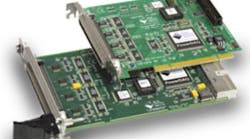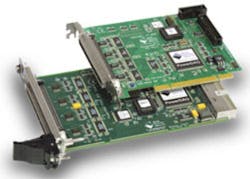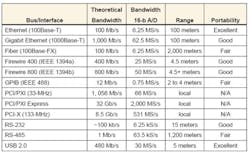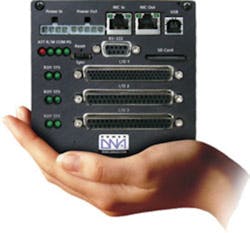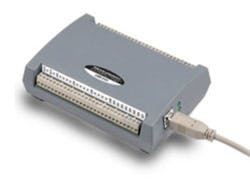Data acquisition systems are available based upon a huge variety of interfaces. Ethernet, PCI, USB, PXI, PCI Express, Firewire, CompactFlash, and even the venerable GPIB, RS-232/485, and ISA bus are all popular. Which ones are the most appropriate for a given application may be far from obvious.
Board vs. Box
Perhaps the first question to address when considering a new data acquisition project is whether your application is best served by a plug-in board system such as PCI or PCI Express or an external box-based system like Ethernet or USB. This issue has been a source of much confusion over the years, and the decision may be less well defined than ever today.
Examples of PCI and PXI BoardsCourtesy of United Electronic Industries
In the early days of PC-based data acquisition, if you wanted high-speed measurements, typically you chose a board solution. If you needed high accuracy, you went for a box. Of course, there was a gray area that could be addressed by either form factor.
Today�s gray area is much larger than ever before. Board-level solutions offering 24-b resolution now are available as well as 6.5-digit DMM boards. On the box side, USB 2.0 theoretically is capable of delivering 30 million 16-b conversions/s while Gigabit Ethernet will handle more than twice that amount.
Although internal plug-in slot data transfer rates have increased tenfold in recent years, the sample rate of a typical data acquisition application has not. Planes and cars don�t go any faster now than in 1980, and temperatures and pressures still are relatively slowly changing phenomena.
Since the accuracy and sample rates of most applications are perfectly within the capabilities of both board- and box-level solutions, other factors must be used to determine which solution is the best for a particular application. Here are some of the key factors:
Distance to the Sensor or Measurement
Distance is an important consideration for two reasons. First, running long wires from your test system and sensors can be a very expensive proposition, especially in large systems. Running a single communications cable is inexpensive.
Each foot of wire connecting your sensor or output to a remote host computer increases your susceptibility to noise. Quiet measurements of 18 b or greater are almost impossible using long connection wires. Mounting the data acquisition system close to the signal source reduces this noise potential.
Portability
Some systems need to be portable. A wide variety of small, external box devices meets this need better than a desktop or tower PC. However, don�t overlook PXI when portability is a requirement. Various compact four- and six-slot chassis are available.
Expandability
Most people assume an external system will allow for more expandability and may be a better selection for a large system than a plug-in board system. That often is true, and most of today�s desktop and tower PCs include only a few I/O slots. However, although considerably more expensive, most servers and industrial computer chassis provide a significant number of slots. Also, PXI chassis with up to 18 slots are available.
Changing or Upgrading
External box systems certainly have the edge here. Even if your next PC is functionally identical to your existing computer, do you really want to remove all your I/O boards and install them in your new computer?
Also, as technology changes, the slots inside computers change. If your current system has four PCI boards in it, are you sure your next PC will have homes for them? Of course, there is no guarantee your next computer will have the same external connections as your current PC, but the probability is almost certainly higher.
Preferred Host Computer
It�s no secret that laptop computers are becoming ever more popular, and their capabilities have expanded to the point where they�re not just for road warriors any longer. Your options for developing a plug-in board-based data acquisition system around your laptop are pretty limited. A variety of PCMCIA/PC card options and a number of CompactFlash-based devices are available, but their capabilities and expandability certainly are limited. However, most new laptops come with Ethernet and USB ports, and many include Firewire as well.
Price
In the past, a plug-in board-based system was likely to carry a smaller price tag. This no longer is the case since some of the lowest cost data acquisition interfaces ever released offer USB or Ethernet interfaces.
Pure Speed
By definition, the internal buses will be faster than those based upon an external communications link. After all, if the computer itself can�t keep up with the speed of an external communications port, the extra speed is unlikely to be useful. However, only the highest speed applications are beyond the capability of USB, Ethernet, or Firewire (Table 1).
Table 1. Various Bus/Interface Specifications
Ethernet
Originally released in 1980, the Ethernet (100Base-T) has become the standard network of PCs worldwide. Oddly, it is only recently that we have seen general acceptance of the Ethernet as a computer interface in data acquisition systems.
Theories abound explaining the Ethernet�s slow migration into data acquisition. Perhaps the most common is that many engineers previously felt Ethernet systems were too difficult to configure, and only trained IT personnel should dare. As the technology advanced, things got simpler. Today, most teenagers are perfectly capable of installing a LAN in their home, and even most of us oldtimers will have an easier time setting up a network than programming a VCR.
The standard Ethernet 100-Mb/s data transfer rate is fast enough for all but the fastest data acquisition applications, and its 100-m range is sufficient for the vast majority of systems. Ethernet systems also can be quite portable since the only tie to the host computer is a CAT5 cable.
Example of Ethernet Data Acquisition BoxCourtesy of United Electronic Industries
Ethernet-based systems are easily expanded as ports may be added with extremely low-cost, off-the-shelf routers. However, users should be careful to keep track of total system bandwidth requirements since all of the devices on a single Ethernet port share the bandwidth.
Ethernet ports are included on virtually all computers sold these days, and most evidence points to this continuing for the foreseeable future. The IEEE has worked very hard to maintain backward compatibility among Ethernet revisions. So even as the Ethernet specification progresses, Ethernet equipment purchased today should be useful for many years to come. Ethernet communications generally are considered very secure and commonly used in some of the largest manufacturing and office facilities.
Interoperability of Ethernet-based data acquisition devices from multiple vendors has not always been stellar. However, most Ethernet-based data acquisition systems are single vendor, and this has not been a major issue in the industry. The LXI Consortium (see sidebar) has developed a specification that ensures simple and seamless multivendor interoperability.
Fiber Ethernet
Boasting the same speed capability of standard Ethernet, the fiber-optic (100Base-FX) implementation extends the range of the system to 2 km. Fiber interfaces are far from standard equipment on today�s PCs, but 100Base-T to 100Base-FX converters and PCI plug-in boards with 100Base-FX interfaces are readily available. For applications requiring even larger distances, single-mode fiber links extend the useful range up to 20 km. However, single-mode fiber systems come with a fairly high price tag.
In addition to their capability to extend control beyond standard Ethernet distances, the fiber interfaces have a number of advantages. First and probably foremost, they are almost immune to electrical and magnetic interference. If your application needs to communicate reliably in a noisy environment, fiber may be the way to go.
Fiber also provides virtually absolute electrical isolation. If there�s a good chance your data acquisition system is going to take a big electrical hit and you want to make sure your host PC doesn�t get fried, look to fiber. Finally, from a security point of view, fiber doesn�t radiate any electrical or magnetic fields that can be sniffed out by uninvited guests.
Firewire
Initially developed by Apple Computer with support from others, Firewire is a high-speed serial interface. The Firewire specification is maintained by IEEE and known as IEEE 1394.
The original spec, known as Firewire 400, was introduced in 1995 and supported 400-Mb/s transfers. In 2002, IEEE-1394b was released and supports data transfer rates up to 800 Mb/s. This version extends the maximum distance between devices beyond the original 4.5 m; however, the maximum data transfer rate is reduced.
The original target markets for Firewire were video and audio products. In these areas, Firewire has been very successful and has a significant market share. It also provides the basic requirements to make it an excellent backbone for data acquisition systems.
However, at approximately the same time Firewire was being promoted, USB was coming online. It appears that USB has won the battle for data acquisition although the reasons are not intuitively obvious. At this time, many data acquisition vendors actively promote USB devices while, with a few exceptions, Firewire successes have been confined to the original target market of audio and video.
Gigabit Ethernet
As the name implies, Gigabit Ethernet (1000Base-T) is a version of Ethernet that supports 1-Gb/s data transfer rates. To take advantage of the Gigabit bandwidth, either Cat5e or Cat6 cables, a Gigabit port in the computer, and Gigabit routers/switches are required.
Gigabit still is a new technology, so most Ethernet-based data acquisition products do not yet support the faster bandwidth. However, the standard Ethernet interface for many new computers now is 1000Base-T capable, and low-cost, off-the-shelf Gigabit routers/switches are available.
Ultimately, most networks of the future will likely be developed as Gigabit. But in most cases, there may be little reason to retrofit existing networks or installations.
GPIB
Originally developed by Hewlett-Packard and designated HPIB, the GPIB bus remains the dominant interconnection standard between computers and instruments although Ethernet and USB are beginning to make inroads. However, as prevalent as GPIB is in test and measurement applications, it never has had a substantial impact on the data acquisition market. A number of GPIB data acquisition products are available, but their market penetration is very small relative to PCI, PXI, Ethernet, and USB-based products.
PCI Bus
The Peripheral Component Interconnect (PCI) bus arguably is the most common data acquisition interface used today. Although Ethernet, USB, and PXI are all significant and growing, PCI still is the workhorse. It is very fast relative to almost all of the external box interconnection systems. PCI slots also are included in virtually all desktop and tower PCs.
PCI originally was developed by Intel as an interface to connect different functions on motherboards. It wasn�t long before it was generalized as a replacement for the aging 16-b ISA bus that had dominated early PCs. With its blazing 33-MHz clock rate, a full 32-b data path, and Windows 95�s excellent support including plug and play, it wasn�t long before the PCI bus had totally eclipsed the ISA bus in new consumer computers.
Although you�d be unlikely to ever find a new computer from one of the major consumer suppliers with an ISA slot, the ISA bus market is surprisingly vibrant. ISA data acquisition boards installed in industrial computers still are the backbone of many systems.
PCI has remained the industry standard since the middle 1990s, but it has not remained stagnant. The PCI standard has moved from 33 MHz to 66 MHz and from a 32-b to a 64-b bus.
As the industry moved from 5-VDC to 3.3-VDC logic, the specification was revised to support both. Throughout all of this, the spec has done a remarkably good job of maintaining backward compatibility, and cards designed in the mid 1990s still may be used in many PCs purchased today.
The original PCI 33-MHz, 32-b spec provided maximum transfer rates of 133 MB/s. This still remains fast enough for all but the most high-speed data acquisition applications.
Most data acquisition boards today only take advantage of 32-b transfers and support both 3.3-VDC and 5-VDC interfaces. A new version of the PCI spec eliminates 5-V support, but it is unknown if this spec will become a common standard or be eclipsed by other technology such as PCI Express.
PCI Express
The latest of the computer interfaces to become common on standard computers, PCI Express is the first all-new plug-in, general-purpose computer bus to become popular since PCI. PCI Express slots now are found in most new desktop and tower PCs.
PCI Express abandoned the parallel data transfer architecture of PCI and PCI-X. Instead, it is based on multiple 2-Gb/s serial paths. The serial nature becomes evident when you look at a PCI Express board and notice how small the board�s PC interface is and how few golden fingers the boards have.
Although 2 Gb/s is quite fast, the PCI Express spec is not done there. It allows up to 16 of these serial links in each direction. The total possible data transfer rate of a full PCI Express implementation is 32 Gb/s in each direction.
It is too early to determine the ultimate impact of PCI Express on the data acquisition market. A variety of data acquisition boards supports PCI Express at this time, but only time will tell whether it or some alternative becomes the next de facto plug-in board standard.
PCI-X
PCI-X, sometimes confused with PCI Express, is a recent variant on the 64-b PCI specification. The original PCI-X spec increased the bus clock speed to 100 MHz and then 133 MHz. A new version of the specification raises the clock rate to as high as 533 MHz.
Even the most recent specification maintains backward compatibility with slower PCI boards, but the legacy boards cannot take advantage of the higher speeds. PCI-X has never become a significant factor in the data acquisition market although there may be a number of PCI-X data acquisition boards available.
PXI
The PXI bus is electrically identical to PCI. However, PXI chassis are developed specifically with data acquisition applications in mind. All boards, including the CPU module, plug in the front of a PXI chassis. This allows much easier installation since no PC cover needs to be removed. Also, the boards are plugged into the front of the chassis, making them much easier to access in most applications.
The PXI specification incorporates much more than simply the computer interface. The PXI backplane also offers a number of powerful triggering capabilities and mandates various good-neighbor requirements so multiple boards from multiple vendors may all be easily integrated.
If there is a downfall, it�s that the CPU modules are specific to the PXI form factor. PXI CPUs don�t take advantage of the economies of scale the consumer PC makers have. As a result, a PXI CPU is likely to cost much more than a computer with equivalent horsepower from a company like Dell, Gateway, or HP. In many applications, the convenience of the PXI form factor more than makes up for the added cost.
PXI has been very well received in the market, and PXI products are available from a very large number of vendors. The specification is controlled by the PXI Systems Alliance.
PXI Express
PXI Express is an implementation of PCI Express. A variety of PXI Express products is available; however, because it is a very new specification, the ultimate acceptance of PXI Express products is difficult to predict.
RS-232
People have been writing eulogies for the venerable RS-232 since I was a young engineer in the early 1980s. However, the last survey result I saw still indicated it was the single most common interface between a PC and an external data acquisition device.
RS-232 is slow, fairly subject to noise, and has fairly short range, yet it remains ubiquitous. However, for the first time, new PCs have supplanted the once-common RS-232 port with USB ports, and most external consumer devices have abandoned RS-232.
RS-422/485
RS-422 and its networkable sibling RS-485 also have been around a long time. Although slow by most standards, RS-422 is fast enough for many applications and has a 1,200-m range. RS-485 has been especially well accepted by manufacturers and buyers of slow, low channel count, remote data acquisition modules.
USB
USB has totally supplanted RS-232 as the communications interface of choice for most consumer items such as printers and cameras. Although the initial releases were slow for a number of applications, version 2.0 has all the bandwidth most data acquisition applications will ever require.
Virtually every new computer includes multiple USB ports. It also has become very popular in the data acquisition marketplace, and a large number of vendors offer USB-based data acquisition.
USB�s simple plug-and-play installation combined with its 480-Mb/s data transfer rate makes it an ideal interface for many data acquisition applications. Because of its popularity in the consumer market, USB components are very inexpensive, and new, low-cost data acquisition devices now are available at previously unheard of prices.
USB�s 5-m range limits the capability to implement remote and distributed I/O systems based on USB. There also is some concern in the industrial arena that the USB connection�s lack of a locking cable mechanism might allow a USB cable to vibrate out of its connector. Whether this is a real possibility or not is certainly open to debate.
Wireless
An entire article could be written on the various different options of wireless technologies and how they could apply to data acquisition. However, right now wireless-based data acquisition hardware represents a miniscule percentage of the market. That�s not to say that 802.11, Zigbee, or some other interface won�t be the standard by which all others are measured in years to come, but we�re certainly not there today.
About the Author
Bob Judd is director of marketing at United Electronic Industries. Prior to joining UEI, he was general manager and vice president of marketing and engineering at Measurement Computing and previously vice president of marketing at MetraByte. Mr. Judd holds a bachelor�s degree in engineering from Brown and a master�s degree in management from MIT. United Electronic Industries, 611 Neponset St., Canton, MA 02021, 781-713-0023, e-mail: [email protected]
FOR MORE INFORMATION
on the PXI specification
www.rsleads.com/701ee-184
on the LXI specification
www.rsleads.com/701ee-185
LXI and Ethernet Data Acquisition
The specification is split into three classes:
� Class C, the simplest class, defines the basic requirements for meeting the LXI specification. Included in Class C are rules and recommendations governing various LAN specifications such as how a device receives its IP address and how it may be discovered on the network, a consistent software application programming interface (API), and a common Web page interface.
� Class B builds upon Class C and adds synchronization over IEEE 1588.
� Class A adds a robust and flexible yet consistent hardware trigger interface.
The consortium actively encourages new memberships from data acquisition and test equipment vendors, system integrators, and end users. The organization holds periodic meetings that provide prospective members with an introduction to the consortium and the LXI specification.
January 2007
